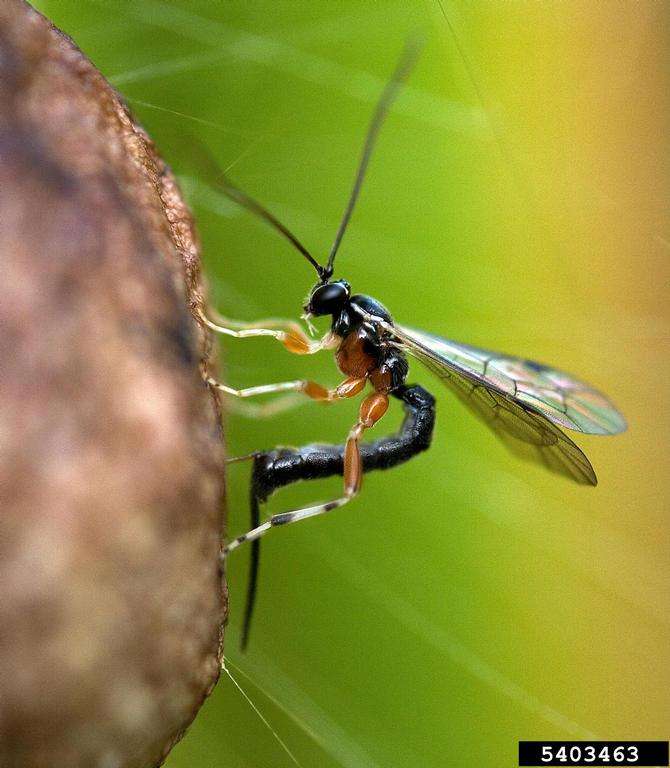
If you’ve been following along with us this summer, you’ll know it’s been one for the bugs! From the usual seasonal suspects to menacing invasive species and occasional beneficial insects – we all ought to be entomologists by now. Nevertheless, we are committed to continuous growth – so let’s learn about another beneficial insect together! Last month we talked about the Minute Pirate Bug, and for this August we are featuring ichneumon wasps! It may be hard to imagine that a wasp can be beneficial to us considering that wasps are often seen as mean bugs that only exist to make our lives difficult and painful. Enter ichneumon wasps – parasitic hunters that serve us and our ecosystem better when spared from the swift wrath of a rolled-up magazine swat.
About Ichneumon Wasps
Ichneumonidae, also referred to as ichneumonids or ichneumon wasps, is a family of over 60,000 species of wasps, over 4,000 of which can be found in the United States! The majority of ichneumon wasps are parasitoids. Parasitoids are insects that develop within or attached to another insect, typically killing the host in the process. We would expect such a predator to be harmful to humans, but the opposite is true.
Despite their unusually long ovipositors, which may get mistaken as a stinger, most ichneumon wasps cannot sting people! Those bizarrely big tail-ends are exclusively used for depositing eggs into host prey. In fact, the word “ichneumon” comes from the Greek words for “tracker” and “footprint”. Female ichneumon wasps can detect prey that lies beneath the bark surface by tapping on the tree. They then use their ovipositor to drill through the bark and lay their egg into the unsuspecting host within the tree. Ichneumons hatch within their hosts and eat them from the inside out. This carnivorous phase lasts until the wasps have reached adulthood. As adults, they consume plant sap and nectar.
Due to the fact that the ichneumon family is so vast, ichneumon wasp appearances can vary greatly depending on the species. Most species have a characteristically thin “waist” where their thorax and abdomen meet, giving them a slender appearance. Their colors range from dark brown to orange as well as other vibrant colors. Another tell-tale way to identity them is by their long ovipositors. Some can grow triple the wasp’s body length to help them reach prey deep within bark!

Interesting Facts:
- There are estimated to be 100,00 species within the ichneumon family. This makes it one of the biggest and most diverse families in the animal kingdom.
- Research has found traces of metal in the tips of ichneumon mandibles and ovipositors. It is believed that this reinforcement helps the females pierce through tree bark to lay their eggs directly into hosts.
- Once ichneumon larvae hatch within their host, they strategically wait until their host has grown big enough to be a fulfilling meal before they begin to eat them.

Benefits of Ichneumonid Wasps
So, what makes these wasps so great anyways? Their diet! Ichneumonids provide essential biological control for key insect pests, such as wood boring insects. Since they prey on insects that are in their pupae stage, ichneumon waps reduce pest populations by decreasing the number of insects that survive until adulthood, thus slowing down the rate of reproduction for that species. This means that your garden veggies will have fewer hungry critters eating them before you have a chance to! Ichneumonids can save you from having to toss out chewed up plants, thus reducing the economic impact of agricultural pests.
Common pests consumed by ichneumon larvae:
- Wood borers
- Weevils
- Sawflies
- Tomato Hornworms
- Armyworms
- Caterpillars
- Spiders
There are currently no methods in place to control ichneumon populations since they are a beneficial species. Additionally, these wasps are not exempt from the merciless food pyramid – they too are preyed on by larger bugs, which in turn helps balance out the ecosystem.
Check out the video below to see the precise process of a female ichneumon wasp laying an egg!
Ways You Can Help
The best way to help ichneumon wasps is simply by leaving them alone. A wasp that doesn’t sting you and eats pesky garden insects? The sounds like a good trade-off! We know it’s often a reflex to swat at a potentially threatening bug, especially if you mistake their long ovipositor for a monstrous stinger, but we encourage you to practice restraint and let these insects continue to help us out! Remember, these wasps are harmless to people.
Bonus tip: Skip pesticides that may harm beneficial insects. Most insecticides will kill beneficial insects along with the targeted pests. If you are concerned about pests but want to keep the good bugs around, check out our Organic Mosquito and Tick Program!



